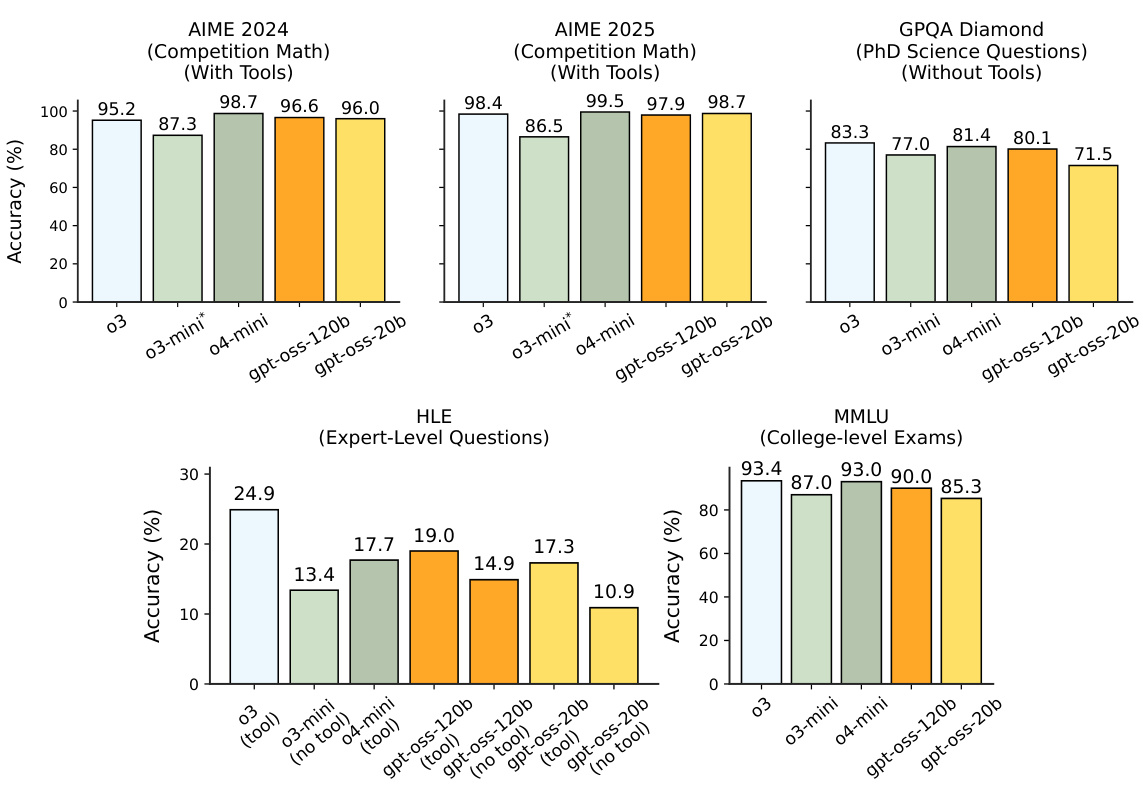OpenAI gpt-oss Models: Technical Breakdown & Real-World Applications
Introduction
On August 5, 2025, OpenAI released two open-source large language models (LLMs) under the Apache 2.0 license: gpt-oss-120b and gpt-oss-20b. These models aim to balance cutting-edge performance with flexibility for developers. This article breaks down their architecture, training methodology, and real-world use cases in plain language.
1. Model Architecture: How They’re Built
1.1 Core Design
Both models use a Mixture-of-Experts (MoE) architecture, a type of neural network that activates only parts of the model for each input. This makes them more efficient than traditional dense models.
| Component | gpt-oss-120b | gpt-oss-20b |
|---|---|---|
| Total Parameters | 116.8B | 20.9B |
| Active Parameters per Token | 5.1B | 3.6B |
| Quantization | MXFP4 (4.25 bits/parameter) | MXFP4 |
Table 1: Key specifications of the two models [citation:1]
1.2 Technical Features
-
Sparse Activation: Only 4 out of 128/32 experts (for 120b/20b) process each token. -
Extended Context: Supports up to 131,072 tokens via YaRN (a context window extension technique). -
Optimized Attention: Uses grouped query attention (GQA) to reduce memory usage.

2. Training Process: From Data to Deployment
2.1 Pre-Training
-
Data Source: Trillions of tokens of text, focusing on STEM, coding, and general knowledge. -
Safety Filter: Content related to hazardous biological/chemical knowledge was filtered using GPT-4o’s CBRN filters. -
Tokenizer: Uses o200k_harmonytokenizer (201k tokens) for multilingual support.
2.2 Post-Training
After pre-training, the models were fine-tuned using Reinforcement Learning from AI Feedback (RLAIF) with three key objectives:
-
Reasoning: Three levels of reasoning effort (low/medium/high) via system prompts. -
Tool Use: -
Web browsing -
Python code execution -
Custom function calls (e.g., for e-commerce APIs).
-
-
Harmony Chat Format: A structured prompt format with roles like System,Developer, andUser.

3. Performance: Benchmarks & Real-World Use
3.1 Core Capabilities
The models were tested on math, science, coding, and multilingual tasks:
| Benchmark | gpt-oss-120b (High Reasoning) | gpt-oss-20b (High) |
|---|---|---|
| AIME 2025 (Math) | 97.9% | 98.7% |
| Codeforces Elo | 2622 | 2516 |
| MMMLU (14 languages) | 81.3% avg. | 75.7% avg. |
Table 3: Performance across key benchmarks [citation:1]
3.1.1 Strengths
-
Math & Logic: Excels at complex reasoning (e.g., AIME problems). -
Coding: Matches OpenAI o4-mini in Codeforces and SWE-Bench Verified scores. -
Multilingual: Supports 14 languages, with Spanish/Portuguese achieving 85%+ accuracy.
3.1.2 Limitations
-
Factuality: Higher hallucination rates on SimpleQA (78.2% for 120b) compared to OpenAI o4-mini. -
Niche Knowledge: Struggles with highly specialized domains (e.g., HLE benchmark).
3.2 Health & Safety
-
HealthBench: 120b model matches OpenAI o3 performance in realistic medical conversations. -
Safety: -
99%+ accuracy in refusing harmful content (e.g., self-harm, violence). -
Robust to jailbreaks but slightly weaker than OpenAI o4-mini in instruction hierarchy tests.
-
4. Practical Applications
4.1 Technical SEO & Content Optimization
The models’ ability to analyze code and generate structured data makes them useful for:
-
Schema Markup: Automatically generating JSON-LD for product pages. -
Content Gap Analysis: Identifying missing keywords in blog posts. -
Multilingual SEO: Translating metadata while maintaining keyword relevance.
Example use case:
# Sample code to generate meta descriptions using gpt-oss-20b
def generate_meta_description(keyword, content):
prompt = f"""As a technical SEO expert, write a concise meta description for a page about {keyword}.
Content snippet: {content}
Requirements: Under 160 characters, include primary keyword."""
return call_model(prompt, reasoning="low")
4.2 YouTube & Video SEO
For video creators, the models can:
-
Keyword Research: Analyze search volume for tags (e.g., using Keywords Everywheredata). -
Transcript Optimization: Generate timestamps and keyword-rich descriptions. -
Thumbnail Text: Suggest text overlays for CTR optimization.

4.3 E-Commerce
-
Product Descriptions: Generate unique, keyword-rich copy at scale. -
FAQ Optimization: Answer common customer queries using structured data.
5. Safety & Limitations
5.1 Risks
-
Hallucinations: May generate plausible but incorrect technical advice. -
Bias: Requires fine-tuning for fairness in hiring/HR applications.
5.2 Mitigation
-
Guardrails: Use system prompts to restrict domains (e.g., medical advice). -
Human-in-the-Loop: Validate outputs for critical tasks.
6. How to Get Started
6.1 Access
-
Download weights via OpenAI’s official channels (Apache 2.0 license). -
Deploy on AWS/GCP with 80GB+ VRAM (120b) or 16GB+ (20b).
6.2 Optimization Tips
-
Quantization: Use 4-bit quantization for faster inference. -
Reasoning Level: Start with lowfor simple tasks,highfor complex analysis.
Conclusion
OpenAI’s gpt-oss models offer a powerful, customizable foundation for technical SEO, content creation, and multilingual applications. While they require careful deployment to mitigate risks, their open-source nature makes them a valuable tool for developers building the next generation of AI-driven solutions.

